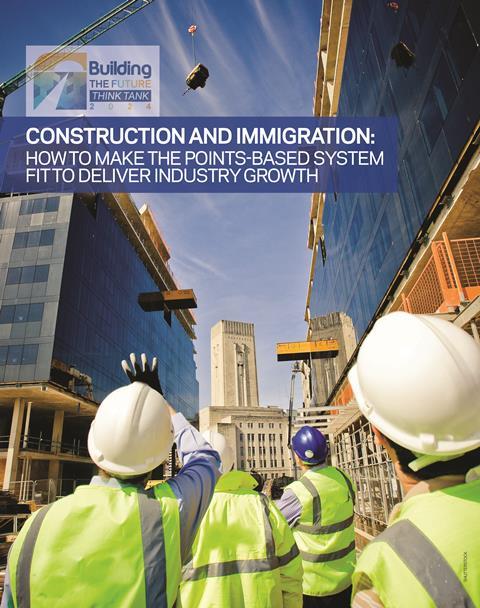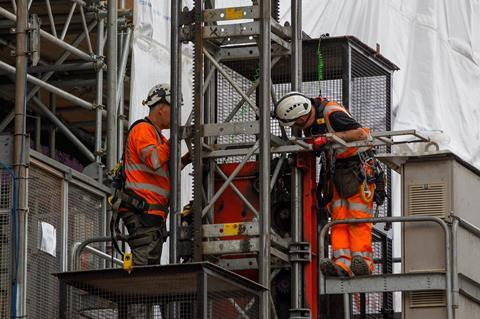In an in-depth report published by the Building the Future Think Tank this week, we look at how Brexit has changed the way we recruit foreign workers – and the implications of that decision. Read the fourth part of our analysis today

This week the Building the Future Think Tank is serialising its 15-page report looking in depth at the current immigration system and its impact on the construction industry. Over five days we will set out the case for reform, culminating in a set of recommendations.
In today’s article, we look at how the new system has made it very difficult for potential workers – skilled and unskilled – to come to this country from Europe.
Barriers to working in the UK
It may be the case that the end of freedom of movement has not resulted in the apocalyptic exodus of foreign-born workers that some feared. But it is certainly true that the UK construction sector has been somewhat protected by a relatively muted trading period, at least since 2022, and that in terms of access to international workers, the points-based system is not delivering. So, what are the major problems, and why is the new system not working?
Low engagement
The foremost issue with the new system appears to be that employers are not engaging with it. In a report published last year, Jonathan Portes of King’s College London and UK in a Changing Europe characterised the government’s main message to industry when launching the new points-based visa system as stressing the need for employers to “adjust” to it. But it appears few in construction have chosen to do so.
As mentioned in the last chapter, the CITB has found that only 7% of employers have signed up as sponsors. A review by the government’s Migration Advisory Committee, published last March, found that the construction sector was responsible for just 1% of visa applications, and overall, the sector “uses the [skilled worker] route much less than we would expect given the overall share of eligible workers in the sector”. According to the Building reader survey, one of the principal barriers to using the points-based system is lack of employer familiarity with system, cited by 42% of respondents, making it the third most significant hurdle.
Bureaucracy and cost
Beyond lack of engagement, there appear to be several specific barriers in employers’ way, related to the design of the system. Notwithstanding evidence that the Home Office replies promptly to applications to register as company sponsors (in as little as a week), and testimony from immigration lawyers to Building’s advisory panel suggesting that the paperwork involved compares favourably with visa processes in other nations, it appears that firms are being put off by the bureaucratic burden.

Previously, under freedom of movement, there was essentially zero paperwork in employing a worker from the EU. Asked why uptake of the new system was so low in the construction sector, respondents to Building’s reader survey most commonly cited excessive bureaucracy or excessive costs and charges in the system. The two issues were cited by 59% and 53% of respondents respectively – significantly higher than for any other potential causes.
The minority of respondents to have actually used the system had had varying experiences, suggesting that at least some fears may be grounded in reality. While 23% recorded good or very good experiences with the system, and 38% okay or neutral, another 38% recorded bad or very bad experiences – close to two-fifths.
>> Also read: Introduction: why the immigration system needs reform for construction to flourish
>> Also read: Immigration: what Brexit changed and how construction has adapted
>> Also read: Immigration: the consequences of ending free movement
One advisory panel member, who reported having spoken to a range of contractors and specialists about the points-based system, said: “A lot of firms said they looked at one page [of the application] and were really scared.
“It’s seen as being very ‘official’. No one gives you free training on how to do the forms, and the government [has this] hostile atmosphere where it’s saying, ‘Well, if you employ someone illegal, it’s a £60,000 fine’.”
Business model
A more fundamental barrier, however, is that the points-based system simply does not fit with the sector’s prevailing employment model for how and when additional workers are demanded. While around two-thirds of construction industry staff are directly employed, the evidence suggests that, prior to Brexit, where EU workers were used by construction firms, it was more often than not on a temporary basis, and under a self-employed status.
This is particularly the case in London, where construction is dominated by large projects requiring very high staffing for specific periods, rather than the ongoing churn of smaller projects seen in the regions.
The terms of the points-based system explicitly rule out bringing in staff on a temporary or self-employed basis (as all skilled workers from overseas must have an agreement from a sponsor firm in the UK that will employ them).
Mark Farmer told the advisory panel that because the contracting model is “project to project” it is to some extent inevitable that the industry has a “business imperative around flexibility”, of which self-employment is a by-product.
Another advisory panel member said that the lack of certainty of workload over a long period means employers and candidates are very reluctant to make the financial commitment needed to employ under the points-based system. “Candidates have often spent £10,000 to get into the country, and you as an employer spend your £1,000. However, if the work dries up, then how the visa is set up [means] they then can’t then go to another employer unless they’re doing the same thing. If not, then they’re back home, and the whole process has to start again.”
How we compiled our report

A survey on key topics was sent out to Building subscribers, which was completed by around 130 consultants, contractors and specialists – as well as others in academia, government and developers. This survey formed a key part of the evidence base for the views of the sector, alongside a desk review of literature on the subject.
In addition, a core group of advisers – the Building the Future Think Tank advisory panel – participated in two roundtable discussions to further develop the themes and ideas in this report.
The feedback from both forums, along with the literature review and the subscriber survey, contributed to the conclusions and recommendations ultimately arrived at. However, the views expressed in the report are those of the author and Building magazine alone, and participants cannot be assumed to have endorsed the final findings.
We are hugely appreciative of the input given by the Building the Future Think Tank advisory panel members. These were:
- David Barnes, head of policy and public affairs, Chartered Institute of Building
- David Bishop, project director, Build UK n James Butcher, director of strategy and operations, National Federation of Builders n Mark Farmer, chief executive, Cast, and government-appointed independent lead reviewer for the arm’s-length body review of industry training boards
- Iain Lindsay, head of talent, John Sisk & Son n Phoebe MacDonald, head of policy and public affairs, RIBA
- Laura Markus, policy and external affairs manager, Home Builders Federation
- Tom Mayhew, partner, Simons Muirhead Burton
- Marley Morris, associate director – migration, trade and communities, Institute for Public Policy Research
- Alasdair Reisner, chief executive, Civil Engineering Contractors Association
- Heather Rolfe, director of research and relationships, British Future
- Daliah Sklar, chief executive, founder and UK immigration expert solicitor solicitor, DRSI Borderless Jobs
- Gary Sullivan, chair, Wilson James
- Rico Wojtulewicz, head of policy and market insight, National Federation of Builders
One recruitment firm, City Site Solutions, which worked widely supplying EU staff into the industry in London before freedom of movement ended, told Building this all means the points-based system “doesn’t work for construction at all”. Darin Burrows, a director at the firm and former vice chair of the Recruitment and Employment Confederation’s construction arm, said this is because the permanent employment model makes recruitment via agency – which was a large feature pre-Brexit – unattractive to the industry and “commercially non-viable”.
“It’s a waste of time; we’ve had not a single appointment via that route. I don’t know of a single competitor that is doing it either,” he said.
Visa requirements
There is also evidence that the availability of candidates to fill roles is being reduced by some of the visa requirements. The significant costs candidates must incur are borne up front and at their own risk, which is incompatible with the inherent instability of construction employment.
The English language test which forms a mandatory part of the skilled worker visa is also seen as reducing the pool of candidates. While Building’s advisory panel took a variety of views on how stringent the test is – with one member describing it as a test of “academic” rather than practical English – there was a widespread view that it is proving a barrier. Whereas previously EU workers might work in the UK as part of a work gang where one member spoke English well and communicated with the client or supervisor, now all workers without exception are required to speak English to a high level. The CECA’s Alasdair Reisner told the panel that the English language test element of the difficulty with the system is “massive” and that overseas workers are being expected to speak better English than many domestic staff display.
In a broader sense, there is a view that candidates have been discouraged from moving to the UK in recent years by the UK’s changed attitude to the EU and to migrants. One panel member said: “We’re just not very attractive to overseas workers at the moment. We’ve had the hostile working environment; we’ve deliberately had a very aggressive approach when it comes to our Brexit negotiations. It’s very difficult to bring dependents over. We’ve made it very difficult for people and, as an individual, it is actually much easier to go to other European countries.”
Salary levels
Beyond these general issues, many of the specific details of the points-based system appear to pose challenges to employers, making it less attractive for them to use. A key issue being raised here is minimum salary thresholds, which were recently increased from the first quartile figure to the 50th percentile figure – in other words, the median salary for that industry. For the general minimum salary threshold, this means it has risen from £26,200 to £38,700 a year.
Meanwhile, the transformation of the shortage occupation list into the immigration salary list has seen the 20% salary discount available to occupations on the list removed. Building’s reader survey found that 36% of respondents blamed minimum salary thresholds for the lack of industry uptake, making it the fourth most commonly cited barrier.
While some on Building’s advisory panel see it as unlikely that experienced tradespeople would have a problem commanding salaries that hit the minimum thresholds, others believe it poses difficulties, particularly given the demographic profile of more mobile, younger workers.
Advisory panel member Phoebe MacDonald, head of policy and public affairs at the RIBA, said the threshold for the job has risen to £45,000, but that even architects with five years’ experience are unlikely to earn that kind of salary.
“The main problem is we know that architects with many years’ experience are not the majority of people that tend to come,” she said. “The people that tend to come to work in the UK are early on in their career, not someone that’s got five years’ experience. If you’re straight out of university, you’re not earning £45,000 a year.”
Lack of a low-skilled route
One of the most fundamental problems with the design of the system, however, is the absence of a route for workers with qualifications lower than RQF level 3 – a qualification equivalent to an advanced apprenticeship, T-level, NVQ level 3 or A-level. The decision not to allow low-skilled workers is a specific policy choice under the points-based system, taken following political promises made in the wake of the Brexit vote.
However, the government has made exceptions to this rule in the horticulture and social care sectors, after representations were made about the scale of reliance on low-skilled workers from overseas in these fields. The horticulture sector benefits from a seasonal worker scheme for fruit-picking which has brought in more than 50,000 people in the past two years, while the social care sector is able to bring in low-skilled staff to fill roles under the health and social care visa scheme.
The construction sector has been consistently lobbying for the government to make a similar exception for the industry, but so far without success. This is despite the fact that a number of occupations where there are acknowledged shortages – such as dryliners and plant operatives – have no level 3 qualifications available.
Evidence submitted by the Construction Leadership Council (CLC) to support its bid for the government to accept low-skilled construction occupations onto the points-based system refers to recent surveys by the National Federation of Builders, the Home Builders Federation and the Federation of Master Builders all identifying a shortage of construction labourers as a barrier to growth. It said these occupations should be included “because of the extreme difficulty faced by companies in accessing domestic labour and the essential nature of these supporting roles to the delivery of construction projects, including those of national priority such as housebuilding, national infrastructure, levelling up and net zero and building safety”.
Last year’s CITB report on migration and construction found that one of the outcomes of the points-based system was that there “has been a reduced flow of workers in the roles – trades and general labourers – where the shortages are most acute”. Building’s reader survey echoed this, with 56% of respondents agreeing that the removal of a route for low-skilled workers to enter the country had contributed to significant problems or skills shortages. In contrast just 13% disagreed with this proposition.
Advisory panel member David Barnes, policy and public affairs manager at the Chartered Institute of Building, said “a lot of the vacancies” are at the lower skill levels and that this means the current system is just “not doing the job”. Another panel member said there is evidence of a 20% shortfall in drylining staff but that the lack of a qualification to level 3 means there is no possibility of bringing them in under the skilled worker visa.
City Site Solutions’ Burrows said that while the current “slack” market means firms are not suffering unduly now, the industry will suffer as soon as it properly recovers. “Suddenly we will see how much of a problem the points-based system is,” he said. “What we really need is labourers – people to do the jobs that UK workers don’t seem to want to do.”

Read the rest of our report in further instalments
Today’s article is the second in a series looking in depth at the current immigration system. Over the coming days we set out the case for reform:
- Already on Building: Introduction: why the immigration system needs reform
- Already on Building: What Brexit changed and how construction has adapted
- Al ready on Building: The consequences of ending free movement
- Tomorrow: How the new system can be reformed and recommendations for change
At the end of the week we will release the full 15-page report, which will be available as a downloadable pdf.
The Building the Future Think Tank is our research hub producing indepth research on behalf of the industry. Last year we published three major reports into ways to shape a better built environment, more research will be published later this month.

Building the Future Conference is back … at Church House, London, 18 September

The Building the Future Conference is set to return to central London on 18 September, bringing together leading industry experts to unpack the biggest issues facing the built environment.
Keynote speakers include Mark Robinson, chief executive, Scape Group, and Eoghan O’Lionaird, chief executive, Wates.
Our panel sessions focus on net zero, building safety and driving productivity on construction projects. They will be fully interactive, allowing you the chance to have your say, and put your questions to any of our expert speakers.
For attendees we will be launching three more research reports linked to the themes of the conference.



























No comments yet